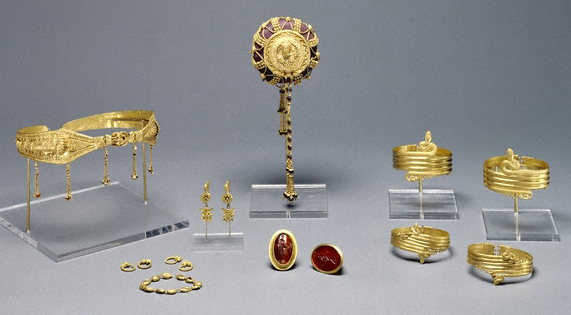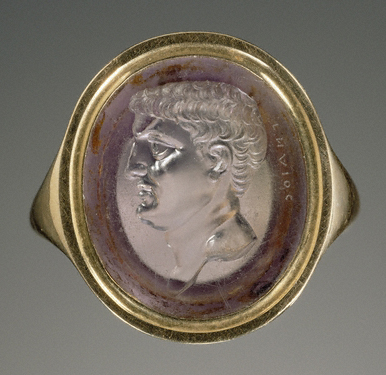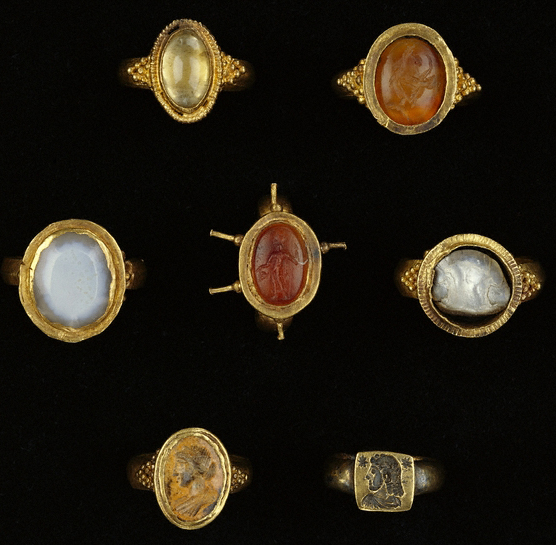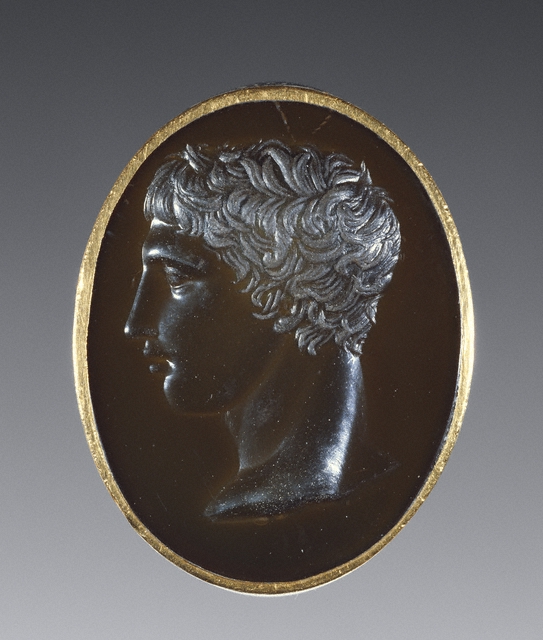There’s not much about ancient civilization Kenneth Lapatin can’t figure out by examining its treasures. As associate curator of antiquities at the J. Paul Getty Museum, he spends his days surrounded by the finest. But the treasures he knows best are the intimate, wearable, precious kind.
Me: You’ve written books about ancient forgery and curated exhibits on Pompeii. What’s your true passion?
KL: My passion is the ancient luxury arts – what others call minor arts or decorative arts – gold work, carved gems and ivories.

Not the kind of antiquity the Getty is famous for. When I think of ancient art at museums, I picture vases and statues.
Most people do because that’s what they see. When most people think of the Ancient Greek and Roman world, we think of marble statues and figured pots. We don’t think of ivories, gems or gold work. Those things have become minor arts in the post-Renaissance view of art history but that doesn’t reflect ancient realities. Of course, larger work like pots and marble statues are what survive well. They’re also easier to display. It’s harder to display gems, but that doesn’t mean we shouldn’t try.
How important were jewelry and carved gems in ancient times, compared to other decorative arts? How was a goldsmith or gem carver perceived, compared to a sculptor or pot maker?

Decorative arts is a modern concept. “ars” in Latin and “techne” in Greek mean “craft” and scholars have long debated the degree to which the ancients conceived of art in the modern sense, or artists. Certainly they valued finely made and beautiful objects and some craftsmen became famous. These Greek artists were the old masters most valued by the Romans. Among them were a few gem engravers and silversmiths, certainly not any potters or pot painters. When you hear about an important ancient pot painter, that’s a modern evaluation.
Craftsmen in general were not well thought of by the upper-class writers who are our contemporary literary sources for the ancient world. There were no muses of the visual arts, but rather literature, poetry, and music. Making what we call art was a dirty, lower-class business – you got sweaty. They admired the work, not the worker.
As to the value of the objects, those made of precious materials – gemstones, ivory, gold, silver, etc. – were intrinsically valuable, and thus were often entrusted to better artists, so their overall quality was much higher.
Gold (except in jewelry) and silver are mostly melted down, ivory and fine textiles have decomposed, but gems often survive in condition similar to that when they left the craftsman’s shop. There is quite a wide variety in quality but the best pieces certainly rival, if not surpass, what we have in other materials. Apart from their high monetary value, they were often personal possessions – intaglios as seals were closely bound up with personal identity – and thus valuable symbolically as well, displayed on significant occasions.

How valuable were these jewels when they were made?
We don’t have a lot of ancient prices, but Pliny the Elder and other ancient authors record very high amounts paid for tables of imported wood and ivory, gems, and hardstone bowls – single objects worth the equivalent of entire estates. Consider too that the most highly valued object in the inventory of possession of Lorenzo d’Medici upon his death in 1492 was an ancient cameo, valued at 10,000 florins. The next most valuable art object was a painting by Fra Angelico at 106 florins.
I think ancient values would have been similar. Painted pottery, being terra cotta, fired earth, was really cheap – which is not to say that it was not beautiful or valued aesthetically, but those who could afford it drank from finely-crafted precious metal or hard stone vessels.
Roman intaglio rings regularly sell for $2000 to $3000 at major auction houses. What should potential buyers know before they buy ancient jewelry?

As you mentioned on your blog, there are a lot of post-antique gems carved in ancient styles. Not all were made as forgeries. Many were carved all’antica, in emulation of ancient works. It’s often difficult to date them if the carver did not make some iconographical mistake, use the wrong shape of stone or material, or the like, because the techniques have not changed all that much over the centuries. On our website, you can find a video we made for last year’s Carvers and Collectors exhibit that shows Chavdar Chushev, a Los Angeles carver, replicating one of the gems. It demystifies the process in about four minutes.
If it’s that easy, how can we be sure we’re getting the real thing, even from Sotheby’s or Christie’s?
I think the experts at the major auction houses are pretty good but we’re all fallible, and not only do we sometimes think early modern items are ancient, we also sometimes condemn ancient work as early modern.
The auction houses do, I think, guarantee what they sell. What buyers should do, in my view, is what they should do in all cases of buying art – buy what they like and what makes them happy at a price they are willing to pay – and not buy for the label.
As I said, there is a wide range in quality in ancient gems. Because they were used as personal seals, people who were not super-rich had them, and the really nice items do sell for quite a lot today, though often still less than pots and other forms of ancient art, which certainly would have surprised the ancients.
I think many people (me included) are fascinated by the idea of owning a piece of the ancient world – especially something precious, hand-made and wearable. Just how wearable is ancient jewelry?
Gold is incorruptible and gemstones are pretty durable, but stones do fall out of mounts, rings can be banged up and earring hooks break, so people should be careful in checking mounts and what they do when wearing this jewelry. When they own something that is already 2,000 years old, they should also consider that it comes with a responsibility, that they should take care so that it will survive them, as it has all these years.
And, it may be something of subjective call, but the higher the quality of the object, the greater the responsibility, and thus, perhaps, the less the piece should be worn. Consider that it might be okay for me to pin a drawing by my friend up on the wall in a bright room, without any protection, but a drawing by Rembrandt should probably be under protective, anti-UV glass and not in the bright light all the time. That sort of thing.
Related:
Ask an Expert: How to buy ancient jewelry for $3,000 or less, interview with G. Max Bernheimer, head of antiquities for Christie’s New York
Holding up an Ancient Mirror, my profile of Kenneth Lapatin for California, UC Berkeley’s alumni magazine
Related products:
Note: Buying through links on this site puts a couple bucks toward blog maintenance.

